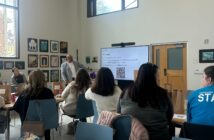
Karen Konkoly
One morning this past winter break I was lying on my kitchen floor reading a book. As I went to turn the page, my book seemed to giggle. When I put it to the side, I realized I was face-to-face with my little sister Abby, hovering over my body in push-up position, inching herself closer and closer to my face.
“Play with me!” she begged. I answered that I would in a little while, but the ensuing reading went quite slowly as Abby proceeded to dance around the room. Every time I looked up she’d be singing, or throwing a ball or chasing our dog.
Abby is 19, by the way, but she has maintained the same level of energy since about age 4.
Since then it has always been the same — no matter how I spend my time with Abby, she inevitably finds ways to squirm, jump, dive, wrestle or run. Although my older sister and I made sure to go to the gym on a regular basis over break, I’m pretty sure that Abby got more exercise just by hanging around our house.
The behavior that Abby exemplifies is called non-exercise activity, a term that encompasses everything we do that requires more exertion than lying down but less exertion than moderate exercise. On average, U.S. adults spend just under two hours every day engaging in non-exercise “lifestyle activities.” The majority of the energy that we use each day is dedicated to such activities, along with subtler forms of non-exercise activity like chewing, typing, or brushing our teeth. Although we tend to associate moderate to high-intensity exercise with healthy outcomes, research suggests that the amount of time we spend in NEA each day plays at least as important a role in overall health.
One 2010 study found that for every additional half hour of NEA you get per day, you lower your risk of metabolic syndrome — a group of symptoms that predisposes you to getting lifestyle diseases like heart disease, stroke, diabetes — by 15 percent. Another found that on average, obese adults spend significantly less time in NEA and significantly more time sitting. Research suggests that even for people at a healthy weight who exercise regularly, the amount of time spent sitting each day is an independent risk factor for poor health.
The proliferation of FitBits and step counters demonstrates that as a society, we are recognizing the importance of NEA. Although these devices promote self-awareness about activity levels, keeping track of our activity won’t just naturally increase the time we spend in NEA (except for moving our arm to look at our FitBits or phones, I guess).
Research demonstrates that genetics play a big role in our automatic tendencies toward NEA. Another study found that after consistent overeating, some people gain very little weight by unconsciously increasing their NEA, while others gain more weight because they do not have a corresponding increase in NEA.
To me, that sounds like great news for little sisters who eat dozens of Christmas cookies and bounce around the house, but not so great news for those more inclined to lay on the floor and read books. Without a natural inclination to engage in NEA, are the rest of us fated to continuously check our FitBits and try to walk in circles until we log ten thousand steps?
Although dedicating ourselves to increasing NEA with conscious effort can be effective, it requires spending the precious and limited resource of willpower. Increasing our natural tendency to engage in NEA can improve health without requiring intentional effort. Plus, the practices we can adopt to naturally increase NEA can help us grow as people.
I advocate a two-pronged approach for increasing NEA without effort. First, maximize energy. Studies have shown that high energy predicts greater NEA, but, unlike traditional exercise, we still feel equally energized after engaging in NEA. Thus, starting out energized can promote NEA for long periods of time. Adequate sleep, tai chi power poses, cold showers, socializing— anything that energizes you can also promote NEA.
Secondly, adopting new hobbies or initiatives to improve other aspects of your life will increase NEA as well. If you were ever on the fence about getting involved in community service or learning the ukulele, remember that nearly any hobby besides Netflix is a great way to increase your NEA. Too busy? Integrate NEA into your current lifestyle by working on your posture, or waving extra enthusiastically to people you know. Take out the trash or wash your roommates’ dishes, just because.
Come on, it’s good for you.
—
Karen Konkoly, ’17, is a columnist for The Brown and White. She can be reached at krk217@lehigh.edu.





Comment policy
Comments posted to The Brown and White website are reviewed by a moderator before being approved. Incendiary speech or harassing language, including comments targeted at individuals, may be deemed unacceptable and not published. Spam and other soliciting will also be declined.
The Brown and White also reserves the right to not publish entirely anonymous comments.
1 Comment
To improve comprehension, I would include NEA in parenthesis when you introduce the concept: Abby’s behavior exemplifies non-exercise activity (NEA). Also, most sources call non-exercise activity thermogenesis NEAT, not NEA. Thanks